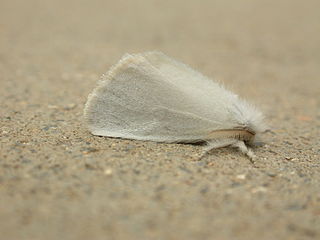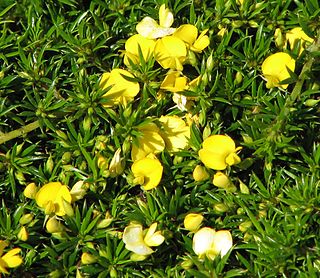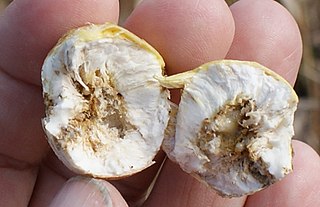
Belgrave Heights is a town in Melbourne, Victoria, Australia, 38 km south-east from Melbourne's central business district. Its local government area is the Shire of Yarra Ranges. At the 2016 census, Belgrave Heights had a population of 1,360.

Pultenaea scabra, the rough bush-pea, is a shrub which is endemic to Australia. It is a member of the family Fabaceae and of the genus Pultenaea.

Pultenaea muelleri is a shrub which is endemic to Victoria, Australia. The species is a member of the family Fabaceae and of the genus Pultenaea. It is a dense shrub that can grow to between 1 and 3 metres in height. The leaves are 10 to 20 mm long, 1 to 2 mm wide and have parallel veins and soft hairs on the undersides. The pea-shaped flowers, which are produced in terminal heads, are yellow with a red centre. These appear between October and January in the species native range.

Acyphas semiochrea is a moth of the subfamily Lymantriinae. It is found along most of the coast of Australia, including: New South Wales, Queensland, South Australia, Tasmania, Victoria and Western Australia.

Mirbelia rubiifolia is a small and spreading shrub in the family Fabaceae. Heath Mirbelia is endemic to Australia. It is found in sclerophyll forest and woodlands, as well as heath on sandy soils on the coast or tablelands, often in areas liable to inundation. Distribution is from Croajingolong National Park in Victoria northward to Queensland.

Pultenaea gunnii, commonly known as golden bush-pea, is a shrub which is endemic to south-eastern Australia. It is a member of the genus Pultenaea and the family Fabaceae. The species occurs in Tasmania, Victoria and New South Wales.

Pultenaea juniperina, or prickly bush-pea, is a plant of the family Fabaceae native to Eastern Australia. It is a shrub to 3 metres sporting showy yellow-orange flowers with red markings. The leaves are 10 – 25 mm long and 1 – 4 mm wide with a pungent leaf apex, hence the use of "Prickly" in the common name. It is widespread and common in heaths, sclerophyll forests and woodlands in Eastern Australia and Tasmania.
Pultenaea sp. Genowlan Point is a critically endangered undescribed species of flowering plant in the family Fabaceae–Faboideae. It is only known from one population at Genowlan Point in the Capertee Valley within the Rylstone local government area of New South Wales.
Pultenaea tenuifolia, commonly known as the slender bush-pea, is a plant which is endemic to Australia. It is a procumbent shrub found in coastal areas of southern Australia and Tasmania with sandy and limestone soils. It has red and yellow flowers.

Pultenaea pedunculata, commonly known as matted bush-pea, is a prostrate shrub that is endemic to south-eastern Australia. It is a member of the genus Pultenaea and the family Fabaceae. The pea flowers are usually yellow with red centres, appearing between September and December in the species native range. The pods which follow are flat and 5 to 7 mm long.

Mount Taylor Conservation Park is a protected area in the Australian state of South Australia located on Kangaroo Island in the gazetted locality of Newland. It was dedicated in 1970 primarily for the conservation of the rare triggerplant Stylidium tepperianum.

Gracillariinae are a subfamily of moths which was described by Henry Tibbats Stainton in 1854.
Pultenaea densifolia is a bush pea that was first described by Ferdinand von Mueller. It has small, leathery, obovate leaves that are bunched together.

Pultenaea stipularis, commonly known as fine-leaf bush-pea, is a prostrate shrub that is endemic to south-eastern Australia. It is a member of the genus Pultenaea and the family Fabaceae.

Yulte Conservation Park is a protected area located in the Australian state of South Australia in the locality of Myponga about 55 kilometres (34 mi) south of the state capital of Adelaide and about 2.5 kilometres (1.6 mi) south-south-east of the town of Myponga.

Pultenaea blakelyi is a shrub that is endemic to south-eastern Australia. Found growing up to four metres tall in dry and wet forest coastal areas, south of Seal Rocks, New South Wales. It is a member of the genus Pultenaea and the family Fabaceae. The specific epithet blakelyi is named for William Blakely.

Pultenaea villosa, the hairy bush-pea, is a shrub which is endemic to south eastern Australia. It is a member of the family Fabaceae and of the genus Pultenaea. A small prostrate or erect shrub. Stems have spreading to curly hairs. The specific epithet villosa is derived from Latin, describing the long loose hairs. This plant first appeared in scientific literature in 1799, in the fourth edition of the Species Plantarum published by the German botanist Carl Ludwig Willdenow.



















